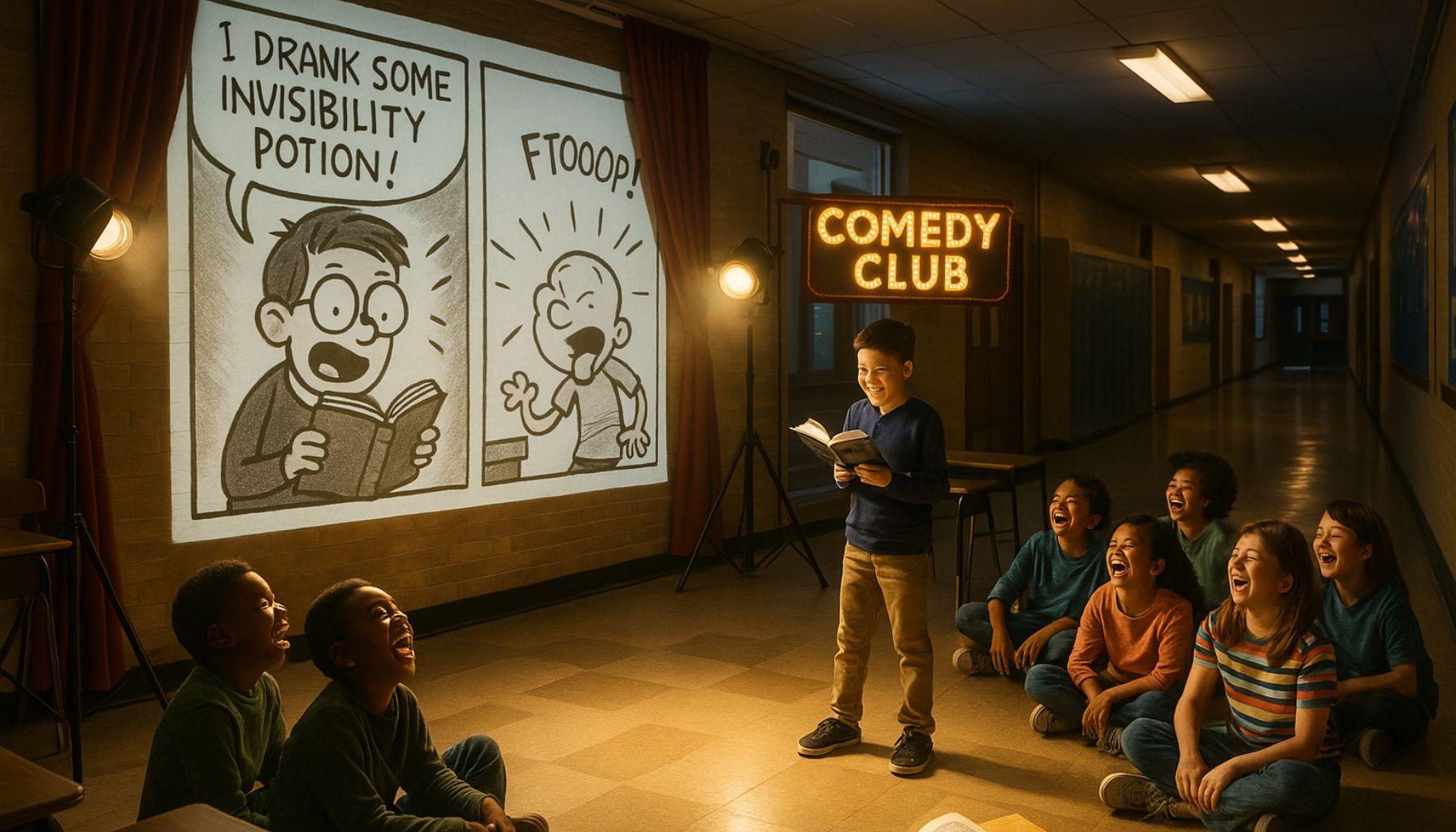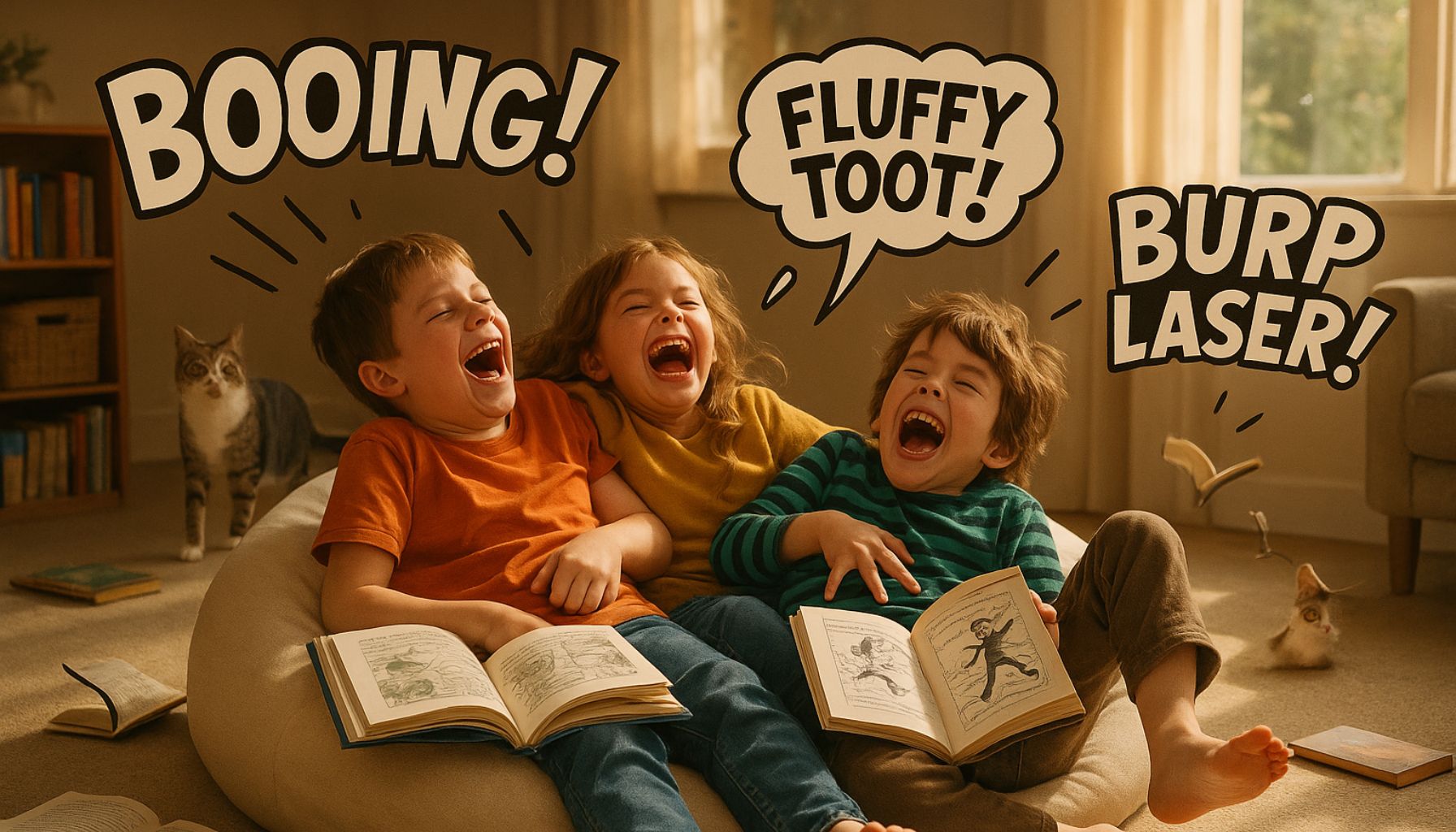Laughter is a universal language that bridges gaps, breaks ice, and most importantly, ignites joy. Within the realm of children’s chapter books, humor holds a transformative power. It beckons even the most hesitant reader to dive into the pages and builds a fortress of love for storytelling that stands the test of time. Imagine a reluctant reader, previously daunted by rows of text, now giggling as they turn the pages—humor is the key that unlocks this joy.
Chapter books brimming with humor create not just entertainment but a learning experience, often without the young reader even realizing it. Laughter can enhance comprehension, as children connect with the fun unfolding in front of them, making complex plots and new vocabulary more approachable. It turns reading from a chore into an adventure, where each page promises smiles and surprise.
Moreover, the joyous sounds of laughter reverberate, leaving echoes that encourage friendships and social bonding. A joke shared over a book can lead to discussions, allowing children to bond over their favorite characters or the silliest situations. Books with comedic flair not only create happy readers but also foster an environment ripe for creativity and conversation.
But beyond immediate joy and understanding, humorous books instill a lifelong love for storytelling. They plant seeds of curiosity and wonder, urging young imaginations to explore, dream, and perhaps one day, create their own narratives filled with humor. Thus, humor in books doesn’t just entertain; it cultivates creators of tomorrow.
The Importance of Humor in Children’s Literature
Humor is not merely a mechanism for entertainment in children’s books; it’s a catalyst for imagination. When a child laughs, they engage with the material on a deeper level, envisioning themselves within the zany worlds and playful scenarios crafted by authors. Whether through a talking hamster or a mischievous ghost, humor unlocks realms where anything is possible, inviting young minds to explore their limits.
Moreover, funny stories often mirror the social dynamics kids navigate daily. They reflect friendships, misunderstandings, or even the chaos of a school day, offering readers a way to process their real-life situations through the safety of fiction. Through shared laughs, children learn empathy and communication, essential skills for social bonding and development.
Relatable characters, silly situations, and wordplay are the triumvirate of effective humor in children’s literature. Relatable yet exaggerated personalities prop up hilarity, while absurd situations elevate the mundane into the extraordinary. Wordplay spins language into a tool for giggles, challenging young readers to appreciate wit and sometimes even discover double meanings hidden in the text.
Free 30-day trial of Amazon Prime
Get your ... Free delivery, award-winning TV, exclusive deals, and more!Elements of a Hilarious Chapter Book
When crafting a hilarious chapter book, certain elements are indispensable. Quirky characters lead the parade, their unique traits serving as the engine of comedy. From a kid inventor whose creations constantly backfire to an animal whisperer who misunderstands “whispers,” these characters invite readers into a world where anything can happen.
Playful language and unexpected twists add to the hilarity. Puns and jokes, tailored to the age group, weave through the narrative, keeping it lively and engaging. Situational comedy emerges from delightful chaos, where predictability is chased away by surprise, ensuring that giggles are never in short supply.
For authors and educators, embracing humor’s wide variety—from the absurd to the clever—is crucial. Different tastes mean varied laughs; the same character quirk might lead one child to chuckle and another to belly laugh. By diversifying comedic elements, stories can reach broader audiences, resonating with children of different humor preferences.
Creating Quirky Characters
Characters with endearing quirks are the heartbeats of humor in chapter books. To craft these vivid personalities, writers often amplify traits that lead to funny scenarios. Picture a detective who’s terribly forgetful or a young magician whose spells are always slightly off—their actions invite laughter and push the story forward in delightful ways.
The dialogue between such characters further amplifies the humor. Snappy banter between a brainy sibling and their overly cautious counterpart can light up the page. Vibrant, eccentric characters thrive on their interactions, with every exchange a potential setup for comic gold.
Characters become more than just vehicles for jokes when they’re given depth. Here are some quirky traits and habits you can use to enhance humor:
- A penchant for inventing imaginary languages.
- Obsessed with an unusual hobby, like competitive yodeling.
- An uncanny ability to speak in rhyme.
- Constantly getting idioms hilariously wrong.
- Fear of extremely specific things, like polka dots.
- Mistook their shadow for a monster (and became friends).
- Convinced they can communicate with vegetables.
- Has a pet rock whose name changes daily.
- Always prepared to solve problems using outdated dance moves.
- Never, ever refuses a dare.
- Thinks they are invisible when closing their eyes.
- Writes letters to inanimate objects and expects replies.
While humor is important, readers tend to remember characters deeply when they can see beyond their comedic facades. Building lovable multi-dimensional characters ensures they linger in the reader’s heart, long after the last page is turned.
Setting the Stage for Comedy
The setting of a story sets the stage—and the stakes—for comedy to unfold. Imagine a world where gravity works in reverse every third Tuesday or a village where everyone wears costumes daily. Such settings provide fertile ground for comedic exploration and the unexpected.
Mismatched worlds, with silly laws and absurd inhabitants, serve as backdrops that enhance the humor, turning every corner into an opportunity for laughter. Envision a town where pets are mayors or a school for talking vegetables—these settings inject individuality into the narrative, shaping the style in which humor unfurls.
Encouraging writers to think outside the box is essential for crafting such inventive worlds. When authors use setting-driven humor, they not only surprise young readers but also keep them engaged. Reading becomes an adventure, where the next page promises new discoveries and delightful absurdity.

Different Flavors of Comedy in Children’s Books
Humor in children’s chapter books comes in many styles, each with its unique flavor. Slapstick offers physical comedy with exaggerated actions and consequences, often leaving characters in bizarre, humorous predicaments. Parody takes well-known stories and flips them upside down, delighting readers with clever twists and familiar yet funny scenarios.
Absurdism creates worlds where logic takes a backseat, inviting laughter through unexpected word combinations and situations. It’s a playground where authors can let loose, knowing that the lack of rules is itself an invitation to have fun. Each style brings its distinct texture, fostering an environment brimming with potential for comedic variety.
| Comedy Style | Typical Characteristics | Examples from Popular Children’s Books |
|---|---|---|
| Slapstick | Physical humor, exaggerated actions | “Captain Underpants” by Dav Pilkey |
| Parody | Twists on familiar stories, satire | “The True Story of the Three Little Pigs” by Jon Scieszka |
| Absurdism | Illogical scenarios, surreal settings | “Alice’s Adventures in Wonderland” by Lewis Carroll |
| Wordplay | Puns, double entendres | “Amelia Bedelia” by Peggy Parish |
| Situational | Humor arising from the plot | “Diary of a Wimpy Kid” by Jeff Kinney |
| Deadpan | Humor delivered with a serious tone | “Series of Unfortunate Events” by Lemony Snicket |
| Irony | Opposite of expected outcomes | “Matilda” by Roald Dahl |
| Hyperbole | Exaggerated descriptions | “The BFG” by Roald Dahl |
| Sarcasm | Mocking tone, intended contrast | “The Bad Beginning” by Lemony Snicket |
| Nonsense | Delight in irrationality | “The Cat in the Hat” by Dr. Seuss |
Blending different styles can keep an audience engrossed and ensure that humor caters to a broader range of preferences. It offers a toolkit for enriching narratives, allowing laughter to flow naturally and resonate with each reader.
Creating Comedy Through Dialogue
Dialogue acts as a crucial vessel for humor, offering a platform for wit and banter in chapter books. Crafting snappy conversations with humor requires an understanding of the timing and rhythm of jokes. Misunderstandings and playful exchanges fuel laughter, as characters navigate interactions with comic flair.
Free 30-day trial of Amazon Prime
Get your ... Free delivery, award-winning TV, exclusive deals, and more!Dialogue-driven humor does more than entertain; it builds character relationships and advances the plot. Through witty repartee, characters reveal their personalities and endear themselves to readers. This type of humor forms an intricate part of storytelling, weaving joy into the narrative’s fabric.
Snappy dialogue combined with well-timed humor has the power to keep readers invested. As characters banter and bicker, they create worlds alive with opportunity and levity. In this dance of words, stories flourish, providing shared laughter and unforgettable moments.
Illustrations as Silent Comedians
Illustrations breathe life into stories, serving as silent comedians that enhance humor in chapter books. Through visual gags, expressive characters, and situational art, illustrations add layers to the comedic narrative, drawing readers deeper into the hilarious world crafted by the author.
Expressive characters in illustrations capture emotions and nuances that words alone sometimes cannot convey. Their exaggerated faces and postures tell stories of their own, often providing the punchline to a textual setup. Situational art adds yet another dimension, with artists crafting humorous scenes that complement and elevate the written word.
Here are some ideas to boost humor through illustrations:
- Facial expressions that exaggerate characters’ reactions.
- Mini-comics within the book pages for quick visual jokes.
- Illustrating improbable scenarios occurring within the background.
- Characters breaking the fourth wall to interact with readers.
- Visualizing quirky character habits creatively.
- Creating “before and after” sequences for comedic impact.
- Unexpected uses of physical space, like characters popping out of frames.
- Including visual puns (e.g., an actual “egg plant”).
- Integrating diagrams with humorous inaccuracies.
- Using illustrative contrast—tiny characters with big objects.
Text and visuals should work in harmony, providing a full comedic experience where the humor leaps off the page and into the reader’s imagination.
Engaging Young Readers with Humor
Capturing a child’s interest often means tuning into the specific humor preferences of the target age group. Recognizing what makes a seven-year-old laugh versus an eleven-year-old is crucial in writing engagingly. Humor opens doors, allowing writers to meet readers where they are.
Strategies to maintain interest include understanding the ebb and flow of comedic timing and deploying surprises where least expected. Books that consistently tickle the funny bone encourage a love for reading and leave children eager for more.
Testing humor with real kids offers valuable feedback, fine-tuning jokes to ensure they’re as funny as intended. This process not only hones the narrative but also shows respect for the audience, ensuring every giggle is genuine and deserved.
Final Thoughts on Crafting Humorous Chapter Books
Crafting humor within chapter books is an art distinct from storytelling alone. It balances creativity, timing, and an understanding of the audience’s sense of fun. Inviting writers to experiment with humor opens the door to innovative narratives and fresh comedic tactics.
By embracing the rich variety within humor, from the absurd to the cleverly witty, authors can create stories that resonate deeply with young readers. Experimentation is key, relishing the joy that laughter brings to both the creator and the reader.
As you pen the pages of your next humorous chapter book, remember that every laugh, chuckle, and giggle invites a child into the world of books. May every reader find joy, and in doing so, discover a love for stories that lasts a lifetime.

